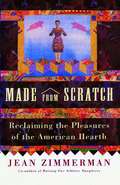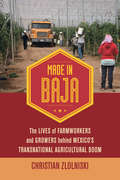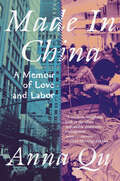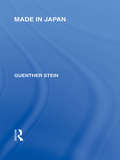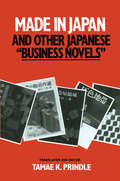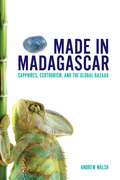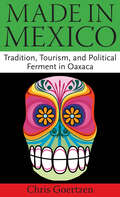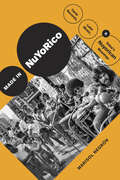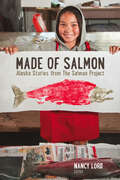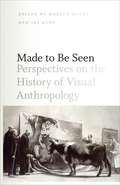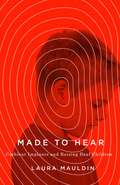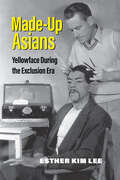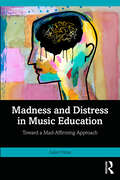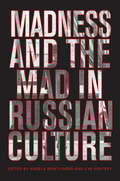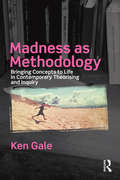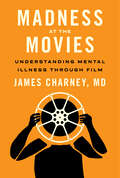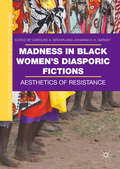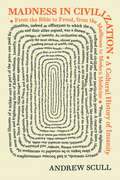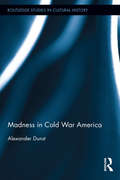- Table View
- List View
Made from Scratch
by Jean ZimmermanIn this stunning celebration and reappraisal of the importance of "women's work," acclaimed journalist Jean Zimmerman poignantly addresses the tug that many Americans of the twenty-first century feel between our professional and private lives. With sharp wit and intelligence, she offers evidence that in the current domestic vacuum, we still long for a richer home life -- a paradox visible in the Martha Stewart phenomenon, in the continuing popularity of women's service magazines such as Better Homes and Gardens, Family Circle, and Ladies' Home Journal -- whose combined circulation of over 17 million is nearly twice the combined circulation of Time, Newsweek, and U.S. News & World Report -- and the booming business of restorations, where onlookers get a hands-on view of domestic life as it flourished in past centuries. This book is about the ways home traditions passed from one generation to the next -- baking a birthday cake from scratch, cherishing family heirlooms, or discovering the satisfaction of piecing a quilt -- sustain our souls, especially in our ever more processed, synthetic world, where we buy "homemade" goods and fail to see the irony in that.Made from Scratch tells the story of the unsung heroines of the hearth, investigating the history of female domesticity and charting its cultural changes over centuries. Zimmerman traces the lives of her own family's homemakers -- from her tiny but indomitable grandmother, who managed a farm, strangled chickens with her bare hands, and sewed all the family clothing, to her mother, who rejected her country upbringing yet kept a fastidious suburban home where the gender divide stayed firmly in place, to her own experiences as a wife and mother weaned on the Women's Movement of the 1970s, with its emphatic view that housework was a dirty word and that the domestic sphere was to be fled rather than cherished. In this book Zimmerman questions the unexamined trade-off we have made in a shockingly brief time span, as we've "progressed" from home-raised chickens to frozen TV dinners to McNuggets from the food court at the mall. What is lost when we no longer engage, as individuals and as a community, in the ancient rituals of food, craft, and shelter?
Made from Scratch: Reclaiming the Pleasures of the American Hearth
by Jean ZimmermanA stunning celebration and reappraisal of the importance of "women's work," Made from Scratch addresses the tug that many Americans feel between our professional and private lives. In this stunning celebration and reappraisal of the importance of "women's work," acclaimed journalist Jean Zimmerman poignantly addresses the tug that many Americans of the twenty-first century feel between our professional and private lives. With sharp wit and intelligence, she offers evidence that in the current domestic vacuum, we still long for a richer home life -- a paradox visible in the Martha Stewart phenomenon, in the continuing popularity of women's service magazines such as Better Homes and Gardens, Family Circle, and Ladies' Home Journal -- whose combined circulation of over 17 million is nearly twice the combined circulation of Time, Newsweek, and U.S. News & World Report -- and the booming business of restorations, where onlookers get a hands-on view of domestic life as it flourished in past centuries. This book is about the ways home traditions passed from one generation to the next -- baking a birthday cake from scratch, cherishing family heirlooms, or discovering the satisfaction of piecing a quilt -- sustain our souls, especially in our ever more processed, synthetic world, where we buy "homemade" goods and fail to see the irony in that.Made from Scratch tells the story of the unsung heroines of the hearth, investigating the history of female domesticity and charting its cultural changes over centuries. Zimmerman traces the lives of her own family's homemakers -- from her tiny but indomitable grandmother, who managed a farm, strangled chickens with her bare hands, and sewed all the family clothing, to her mother, who rejected her country upbringing yet kept a fastidious suburban home where the gender divide stayed firmly in place, to her own experiences as a wife and mother weaned on the Women's Movement of the 1970s, with its emphatic view that housework was a dirty word and that the domestic sphere was to be fled rather than cherished. In this book Zimmerman questions the unexamined trade-off we have made in a shockingly brief time span, as we've "progressed" from home-raised chickens to frozen TV dinners to McNuggets from the food court at the mall. What is lost when we no longer engage, as individuals and as a community, in the ancient rituals of food, craft, and shelter?
Made in America: A Social History of American Culture and Character
by Claude S. FischerOur nation began with the simple phrase, "We the People." But who were and are "We"? Who were we in 1776, in 1865, or 1968, and is there any continuity in character between the we of those years and the nearly 300 million people living in the radically different America of today? With Made in America, Claude S. Fischer draws on decades of historical, psychological, and social research to answer that question by tracking the evolution of American character and culture over three centuries. He explodes myths-such as that contemporary Americans are more mobile and less religious than their ancestors, or that they are more focused on money and consumption-and reveals instead how greater security and wealth have only reinforced the independence, egalitarianism, and commitment to community that characterized our people from the earliest years. Skillfully drawing on personal stories of representative Americans, Fischer shows that affluence and social progress have allowed more people to participate fully in cultural and political life, thus broadening the category of "American" -yet at the same time what it means to be an American has retained surprising continuity with much earlier notions of American character. Firmly in the vein of such classics as The Lonely Crowd and Habits of the Heart--yet challenging many of their conclusions--Made in America takes readers beyond the simplicity of headlines and the actions of elites to show us the lives, aspirations, and emotions of ordinary Americans, from the settling of the colonies to the settling of the suburbs.
Made in Baja: The Lives of Farmworkers and Growers behind Mexico's Transnational Agricultural Boom
by Christian ZlolniskiMuch of the produce that Americans eat is grown in the Mexican state of Baja California, the site of a multibillion-dollar export agricultural boom that has generated jobs and purportedly reduced poverty and labor migration to the United States. But how has this growth affected those living in Baja? Based on a decade of ethnographic fieldwork, Made in Baja examines the unforeseen consequences for residents in the region of San Quintín. The ramifications include the tripling of the region’s population, mushrooming precarious colonia communities lacking basic infrastructure and services, and turbulent struggles for labor, civic, and political rights. Anthropologist Christian Zlolniski reveals the outcomes of growers structuring the industry around an insatiable demand for fresh fruits and vegetables. He also investigates the ecological damage—"watercide”—and the social side effects of exploiting natural resources for agricultural production. Weaving together stories from both farmworkers and growers, Made in Baja provides an eye-opening look at the dynamic economy developing south of the border.
Made in China: A Memoir of Love and Labor
by Anna QuA young girl forced to work in a Queens sweatshop calls child services on her mother in this powerful debut memoir about labor and self-worth that traces a Chinese immigrant's journey to an American future. <p><p> As a teen, Anna Qu is sent by her mother to work in her family's garment factory in Queens. At home, she is treated as a maid and suffers punishment for doing her homework at night. Her mother wants to teach her a lesson: she is Chinese, not American, and such is their tough path in their new country. But instead of acquiescing, Qu alerts the Office of Children and Family Services, an act with consequences that impact the rest of her life. Nearly twenty years later, estranged from her mother and working at a Manhattan start-up, Qu requests her OCFS report. When it arrives, key details are wrong. <p><p> Faced with this false narrative, and on the brink of losing her job as the once-shiny start-up collapses, Qu looks once more at her life's truths, from abandonment to an abusive family to seeking dignity and meaning in work. Traveling from Wenzhou to Xi'an to New York, Made in China is a fierce memoir unafraid to ask thorny questions about trauma and survival in immigrant families, the meaning of work, and the costs of immigration.
Made in Japan (Routledge Library Editions: Japan)
by Guenther SteinThis volume concentrates on the effect of Japanese trade competition on the UK and Europe, it also provides an illuminating picture of political, social and military conditions in Japan in the early twentieth century.
Made in Japan and Other Japanese Business Novels
by Tamae K. PrindleThe term "business novel" is a translation of the Japanese word kezai shosetsu, which may be translated literally as * 'economy novel.'' Critic Makoto Sataka first used the word "business" in place of "economy" in his monograph How to Read Business Novels (1980).l Business novels are "popular novels" (taishu bungaku) widely read by Japanese businessmen, their wives, students, and other professionals.. Business novels were recognized as a * 'field'' or a literary sub-genre in the late 1950s. It was Saburo Shiroyama's Export (Yushutsu) (1957), if not his Kinjo the Corporate Bouncer (Sokaiya Kinjo) (1959), which marshalled their enormous popularity. The seven short works in this collection represent prototypes of the business novel. Their distinctive features are that business activities motivate plot developments, although psycho-socio-cultural elements are tightly interwoven.
Made in Madagascar: Sapphires, Ecotourism, And The Global Bazaar (Teaching Culture: Utp Ethnographies For The Classroom Ser.)
by Andrew WalshSince the 1990s, the Ankarana region of northern Madagascar has developed a reputation among globe-trotting gemstone traders and tourists as a source of some of the world's most precious natural wonders. Although some might see Ankarana's sapphire and ecotourist trades as being at odds with each other, many local people understand these trades to be fundamentally connected, most obviously in how both serve foreign demand for what Madagascar has to offer the world. Walsh explores the tensions and speculations that have come with the parallel emergence of these two trades with sensitivity and a critical eye, allowing for insights into globalization, inequality, and the appeal of the "natural." For more information, and to read a hyperlinked version of the first chapter online, visit www.madeinmadagascar.org.
Made in Mexico: Tradition, Tourism, and Political Fermant in Oaxaca
by Chris GoertzenMade in Mexico examines the aesthetic, political, and sociopolitical aspects of tourism in southern Mexico, particularly in the state of Oaxaca. Tourists seeking "authenticity" buy crafts and festival tickets and spend even more on travel expenses. What does a craft object or a festival moment need to look like or sound like to please both tradition bearers and tourists in terms of aesthetics? Under what conditions are transactions between these parties psychologically healthy and sustainable? What political factors can interfere with the success of this negotiation, and what happens when the process breaks down? With Subcommandante Marcos and the Zapatistas still operating in neighboring Chiapas and unrest on the rise in Oaxaca itself, these are not merely theoretical problems. Chris Goertzen analyzes the nature and meaning of a single craft object, a woven pillowcase from Chiapas, thus previewing what the book will accomplish in greater depth in Oaxaca. He introduces the book's guiding concepts, especially concerning the types of aesthetic intensification that have replaced fading cultural contexts, and the tragic partnership between ethnic distinctiveness and oppressive politics. He then brings these concepts to bear on crafts in Oaxaca and on Oaxaca's Guelaguetza, the anchor for tourism in the state and a festival with an increasingly contested meaning.
Made in NuYoRico: Fania Records, Latin Music, and Salsa’s Nuyorican Meanings (Refiguring American Music)
by Marisol NegrónIn Made in NuYoRico, Marisol Negrón tells the cultural history of salsa, tracing the music’s Nuyorican meanings over a fifty-year period that begins with the establishment of Fania Records in 1964 and how it capitalized on salsa’s Nuyorican imaginary to cultivate a global audience. Drawing on interviews with fans, legendary musicians, and music industry figures as well as analyses of songs, albums, films, and archival documents, Negrón shows how Nuyorican cultural and social histories became embedded in and impacted salsa music's flows during its foundational period in the mid-1960s and its boom in the 1970s. Salsa’s Nuyorican aesthetics challenged mainstream notions of Americanness and Puerto Ricanness and produced an alternative public sphere through which New York’s poor and working-class Puerto Ricans could contest racialization and colonial power. By outlining salsa’s complicated musical, cultural, commercial, racial, gendered, legal, and political entanglements, Negrón demonstrates its centrality to Nuyorican identity and subjectivity.
Made in Scotland: Studies in Popular Music (Routledge Global Popular Music Series)
by John Williamson Simon Frith Martin CloonanMade in Scotland: Studies in Popular Music serves as a comprehensive and thorough introduction to the history, politics, culture, and musicology of twentieth- and twenty-first-century popular music in Scotland. The volume consists of essays by local experts and leading scholars in Scottish music and culture, and covers the major figures, styles, and social contexts of popular music in Scotland. Each essay provides adequate context so readers understand why the figure or genre under discussion is of lasting significance. The book includes a general introduction to Scottish popular music, followed by essays organized into three thematic sections: Histories, Politics and Policies, and Futures and Imaginings. Examining music as cultural expression in a country that is both a nation and a region within a larger state, this volume uses popular music to analyse Scottishness, independence, and diversity and offers new insights into the complexity of cultural identity, the power of historical imagination, and the effects of power structures in music. It is a vital read for scholars and students interested in how popular music interacts with and shapes such issues both within and beyond the borders of Scotland.
Made in the Philippines (Routledge Pacific Rim Geographies #Vol. 5)
by James A. TynerThe Philippines is the world's largest exporter of temporary contract labor with a huge 800,000 workers a year being deployed on either six month or two year contracts. This labor migration is highly regulated by the government, private, and non-governmental/non-private organizations. Tyner argues that migrants are socially constructed, or 'made' by these parties and that migrants in turn become political resources. Employing a post-structural feminist perspective Tyner questions the very ontology of migration.
Made of Salmon: Alaska Stories from the Salmon Project
by Nancy LordAll over the world, salmon populations are in trouble, as overfishing and habitat loss have combined to put the once-great Atlantic and Pacific Northwest runs at serious risk. Alaska, however, stands out as a rare success story: its salmon populations remain strong and healthy, the result of years of careful management and conservation programs that are rooted in a shared understanding of the importance of the fish to the life, culture, and history of the state. Made of Salmon brings together more than fifty diverse Alaska voices to celebrate the salmon and its place in Alaska life. A mix of words and images, the book interweaves longer works by some of Alaska’s finest writers with shorter, more anecdotal accounts and stunning photographs of Alaskans fishing for, catching, preserving, and eating salmon throughout the state. A love letter to a fish that has been central to Alaska life for centuries, Made of Salmon is a reminder of the stakes of this great, ongoing conservation battle.
Made to Be Seen: Perspectives on the History of Visual Anthropology
by Marcus Banks and Jay RubyMade to be Seen brings together leading scholars of visual anthropology to examine the historical development of this multifaceted and growing field. Expanding the definition of visual anthropology beyond more limited notions, the contributors to Made to be Seen reflect on the role of the visual in all areas of life. Different essays critically examine a range of topics: art, dress and body adornment, photography, the built environment, digital forms of visual anthropology, indigenous media, the body as a cultural phenomenon, the relationship between experimental and ethnographic film, and more. The first attempt to present a comprehensive overview of the many aspects of an anthropological approach to the study of visual and pictorial culture, Made to be Seen will be the standard reference on the subject for years to come. Students and scholars in anthropology, sociology, visual studies, and cultural studies will greatly benefit from this pioneering look at the way the visual is inextricably threaded through most, if not all, areas of human activity.
Made to Hear: Cochlear Implants and Raising Deaf Children (A Quadrant Book)
by Laura MauldinA mother whose child has had a cochlear implant tells Laura Mauldin why enrollment in the sign language program at her daughter&’s school is plummeting: &“The majority of parents want their kids to talk.&” Some parents, however, feel very differently, because &“curing&” deafness with cochlear implants is uncertain, difficult, and freighted with judgment about what is normal, acceptable, and right. Made to Hear sensitively and thoroughly considers the structure and culture of the systems we have built to make deaf children hear.Based on accounts of and interviews with families who adopt the cochlear implant for their deaf children, this book describes the experiences of mothers as they navigate the health care system, their interactions with the professionals who work with them, and the influence of neuroscience on the process. Though Mauldin explains the politics surrounding the issue, her focus is not on the controversy of whether to have a cochlear implant but on the long-term, multiyear undertaking of implantation. Her study provides a nuanced view of a social context in which science, technology, and medicine are trusted to vanquish disability—and in which mothers are expected to use these tools. Made to Hear reveals that implantation has the central goal of controlling the development of the deaf child&’s brain by boosting synapses for spoken language and inhibiting those for sign language, placing the politics of neuroscience front and center.Examining the consequences of cochlear implant technology for professionals and parents of deaf children, Made to Hear shows how certain neuroscientific claims about neuroplasticity, deafness, and language are deployed to encourage compliance with medical technology.
Made-Up Asians: Yellowface During the Exclusion Era
by Esther Kim LeeMade-Up Asians traces the history of yellowface, the theatrical convention of non-Asian actors putting on makeup and costume to look East Asian. Using specific case studies from European and U.S. theater, race science, and early film, Esther Kim Lee traces the development of yellowface in the U.S. context during the Exclusion Era (1862–1940), when Asians faced legal and cultural exclusion from immigration and citizenship. These caricatured, distorted, and misrepresented versions of Asians took the place of excluded Asians on theatrical stages and cinema screens. The book examines a wide-ranging set of primary sources, including makeup guidebooks, play catalogs, advertisements, biographies, and backstage anecdotes, providing new ways of understanding and categorizing yellowface as theatrical practice and historical subject. Made-Up Asians also shows how lingering effects of Asian exclusionary laws can still be seen in yellowface performances, casting practices, and anti-Asian violence into the 21st century.
Madison County, Mississippi (Black America Series)
by Jennifer E. Cheeks-CollinsKnown as the "Land Between Two Rivers," Madison County is situated between the Pearl River to the east and the Big Black River to the west. It was created in 1828, and African slaves were among its earliest settlers. As the county grew, the African-American society began to create roots in this region, and their legacy continues to this day. Black America: Madison County explores a community marked by struggle, poverty, and segregation, a community that finally gained its voice during the Civil Rights Movement of the 1960s. This volume celebrates the lives of Madison County's black residents-past and present-and tells their story through vintage photographs.
Madness and Crime: Critical Concepts In Criminology
by Philip BeanThis book provides an authoritative and highly readable review of the relationship between madness and crime by one of the leading authorities in the field. The book is divided into four parts, each essay focusing on selected features of madness which have relevance to contemporary society. Part 1 is about madness itself, exploring three main models − cognitive, statistical, and emotional. Part 2 is a short discussion on madness, genius and creativity. Part 3 is about the much neglected area of compulsion, an issue that has largely disappeared from public debate. The mad may have moved from victim to violator, yet fundamental questions remain − in particular how to justify compulsory detention, and who should undertake the process? The answers to these questions have sociological, ethical and jurisprudential elements, and cannot just re resolved by reference to medical authorities. Part 4 is about the links between madness and crime − focusing less on the question and nature of criminal responsibility and the various defences that go with this, more on the links between madness and crime and which particular crimes are linked with which types of disorder.
Madness and Distress in Music Education: Toward a Mad-Affirming Approach
by Juliet HessMadness and Distress in Music Education offers an in-depth exploration of mental health and emotional distress in the context of music education, offering new ways of thinking about these experiences and constructing ways to support distress through affirming pedagogy, practices, and policies in music education. Centering the lived experiences of 15 people in a range of roles across music education who self-identify an issue with their mental health, the volume addresses impacts on both students and educators. The author draws on Mad Studies and disability studies to present new paradigms for thinking about Madness and distress in the music context. An essential resource for music educators, music education researchers, and preservice students seeking to understand the complexities of mental health in the music classroom, this book considers how people conceptualize their mental health, how distress impacts participation in music education, how music education may support or exacerbate distress, and what supports for distress can be implemented in music education.
Madness and the Mad in Russian Culture
by Ilya Vinitsky Angela BrintlingerThe problem of madness has preoccupied Russian thinkers since the beginning of Russia's troubled history and has been dealt with repeatedly in literature, art, film, and opera, as well as medical, political, and philosophical essays. Madness has been treated not only as a medical or psychological matter, but also as a metaphysical one, encompassing problems of suffering, imagination, history, sex, social and world order, evil, retribution, death, and the afterlife.Madness and the Mad in Russian Culture represents a joint effort by American, British, and Russian scholars - historians, literary scholars, sociologists, cultural theorists, and philosophers - to understand the rich history of madness in the political, literary, and cultural spheres of Russia. Editors Angela Brintlinger and Ilya Vinitsky have brought together essays that cover over 250 years and address a wide variety of ideas related to madness - from the involvement of state and social structures in questions of mental health, to the attitudes of major Russian authors and cultural figures towards insanity and how those attitudes both shape and are shaped by the history, culture, and politics of Russia.
Madness as Methodology: Bringing Concepts to Life in Contemporary Theorising and Inquiry
by Ken GaleMadness as Methodology begins with the following quotation from Deleuze and Guattari, ‘Madness need not be all breakdown. It may also be breakthrough.’ This quotation firmly expresses the book’s intention to provide readers with radical and innovative approaches to methodology and research in the arts, humanities and education practices. It conceptualises madness, not as a condition of an individual or particular being, but rather as a process that does things differently in terms of creativity and world making. Through a posthuman theorising as practice, the book emphasises forms of becoming and differentiation that sees all bodies, human and nonhuman, as acting in constant, fluid, relational play. The book offers a means of breaking through and challenging the constraints and limitations of Positivist approaches to established research practice. Therefore, experimentation, concept making as event and a going off the rails are offered as necessary means of inquiry into worlds that are considered to be always not yet known. Rather than using a linear chapter structure, the book is constructed around Deleuze and Guattari’s use of an assemblage of plateaus, providing the reader with a freedom of movement via multiple entry and exit points to the text. These plateaus are processually interconnected providing a focal emphasis upon topics apposite to this madness as methodology. Therefore, as well as offering a challenge to the constraining rigours of conventional research practices, these plateaus engage with topics to do with posthuman thinking, relationality, affect theory, collaboration, subjectivity, friendship, performance and the use of writing as a method of inquiry.
Madness at the Movies: Understanding Mental Illness through Film
by James CharneyA unique exploration of how mental illness is portrayed in classic and contemporary films.The study of classic and contemporary films can provide a powerful avenue to understand the experience of mental illness. In Madness at the Movies, James Charney, MD, a practicing psychiatrist and long-time cinephile, examines films that delve deeply into characters' inner worlds, and he analyzes moments that help define their particular mental illness. Based on the highly popular course that Charney taught at Yale University and the American University of Rome, Madness at the Movies introduces readers to films that may be new to them and encourages them to view these films in an entirely new way. Through films such as Psycho, Taxi Driver, Through a Glass Darkly, Night of the Hunter, A Woman Under the Influence, Ordinary People, and As Good As It Gets, Charney covers an array of disorders, including psychosis, paranoia, psychopathy, depression, bipolar disorder, obsessive-compulsive disorder, and anxiety. He examines how these films work to convey the essence of each illness. He also looks at how each film reflects the understanding of mental illness at the time it was released as well as the culture that shaped that understanding.Charney explains how to observe the behaviors displayed by characters in the films, paying close attention to signs of mental illness. He demonstrates that learning to read a film can be as absorbing as watching one. By viewing these films through the lens of mental health, readers can hone their observational skills and learn to assess the accuracy of depictions of mental illness in popular media.
Madness in Black Women’s Diasporic Fictions
by Caroline A. Brown Johanna X. K. GarveyThis collection chronicles the strategic uses of madness in works by black women fiction writers from Africa, the Caribbean, Canada, Europe, and the United States. Moving from an over-reliance on the "madwoman" as a romanticized figure constructed in opposition to the status quo, contributors to this volume examine how black women authors use madness, trauma, mental illness, and psychopathology as a refraction of cultural contradictions, psychosocial fissures, and political tensions of the larger social systems in which their diverse literary works are set through a cultural studies approach. The volume is constructed in three sections: Revisiting the Archive, Reinscribing Its Texts: Slavery and Madness as Historical Contestation, The Contradictions of Witnessing in Conflict Zones: Trauma and Testimony, and Novel Form, Mythic Space: Syncretic Rituals as Healing Balm. The novels under review re-envision the initial trauma of slavery and imperialism, both acknowledging the impact of these events on diasporic populations and expanding the discourse beyond that framework. Through madness and healing as sites of psychic return, these novels become contemporary parables of cultural resistance.
Madness in Civilization
by Andrew ScullThe loss of reason, a sense of alienation from the commonsense world we all like to imagine we inhabit, the shattering emotional turmoil that seizes hold and won't let go--these are some of the traits we associate with madness. Today, mental disturbance is most commonly viewed through a medical lens, but societies have also sought to make sense of it through religion or the supernatural, or by constructing psychological or social explanations in an effort to tame the demons of unreason. Madness in Civilization traces the long and complex history of this affliction and our attempts to treat it.Beautifully illustrated throughout, Madness in Civilization takes readers from antiquity to today, painting a vivid and often harrowing portrait of the different ways that cultures around the world have interpreted and responded to the seemingly irrational, psychotic, and insane. From the Bible to Sigmund Freud, from exorcism to mesmerism, from Bedlam to Victorian asylums, from the theory of humors to modern pharmacology, the book explores the manifestations and meanings of madness, its challenges and consequences, and our varied responses to it. It also looks at how insanity has haunted the imaginations of artists and writers and describes the profound influence it has had on the arts, from drama, opera, and the novel to drawing, painting, and sculpture.Written by one of the world's preeminent historians of psychiatry, Madness in Civilization is a panoramic history of the human encounter with unreason.
Madness in Cold War America: Mad America (Routledge Studies in Cultural History)
by Alexander DunstThis book tells the story of how madness came to play a prominent part in America’s political and cultural debates. It argues that metaphors of madness rise to unprecedented popularity amidst the domestic struggles of the early Cold War and become a pre-eminent way of understanding the relationship between politics and culture in the United States. In linking the individual psyche to society, psychopathology contributes to issues central to post-World War II society: a dramatic extension of state power, the fate of the individual in bureaucratic society, the political function of emotions, and the limits to admissible dissent. Such vocabulary may accuse opponents of being crazy. Yet at stake is a fundamental error of judgment, for which madness provides welcome metaphors across US diplomacy and psychiatry, social movements and criticism, literature and film. In the process, major parties and whole historical eras, literary movements and social groups are declared insane. Reacting against violence at home and war abroad, countercultural authors oppose a sane madness to irrational reason—romanticizing the wisdom of the schizophrenic and paranoia’s superior insight. As the Sixties give way to a plurality of lifestyles an alternative vision arrives: of a madness now become so widespread and ordinary that it may, finally, escape pathology.
